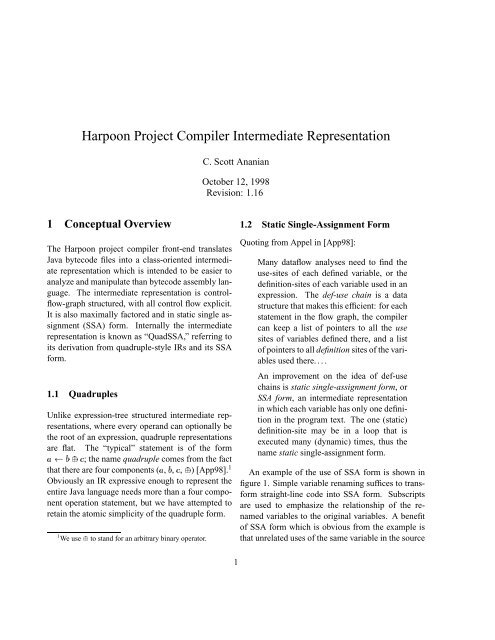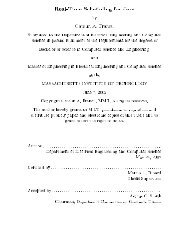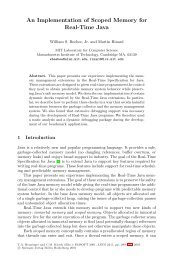Harpoon Project Compiler Intermediate Representation
Harpoon Project Compiler Intermediate Representation
Harpoon Project Compiler Intermediate Representation
Create successful ePaper yourself
Turn your PDF publications into a flip-book with our unique Google optimized e-Paper software.
<strong>Harpoon</strong> <strong>Project</strong> <strong>Compiler</strong> <strong>Intermediate</strong> <strong>Representation</strong><br />
C. Scott Ananian<br />
October 12, 1998<br />
Revision: 1.16<br />
1 Conceptual Overview<br />
The <strong>Harpoon</strong> project compiler front-end translates<br />
Java bytecode files into a class-oriented intermediate<br />
representation which is intended to be easier to<br />
analyze and manipulate than bytecode assembly language.<br />
The intermediate representation is controlflow-graph<br />
structured, with all control flow explicit.<br />
It is also maximally factored and in static single assignment<br />
(SSA) form. Internally the intermediate<br />
representation is known as “QuadSSA,” referring to<br />
its derivation from quadruple-style IRs and its SSA<br />
form.<br />
1.1 Quadruples<br />
Unlike expression-tree structured intermediate representations,<br />
where every operand can optionally be<br />
the root of an expression, quadruple representations<br />
are flat.<br />
The “typical” statement is of the form<br />
¢¡¤£¦¥¨§<br />
; the name quadruple comes from the fact<br />
that there are four components ( , £ , § , ¥ ) [App98]. 1<br />
Obviously an IR expressive enough to represent the<br />
entire Java language needs more than a four component<br />
operation statement, but we have attempted to<br />
retain the atomic simplicity of the quadruple form.<br />
1 We use © to stand for an arbitrary binary operator.<br />
1.2 Static Single-Assignment Form<br />
Quoting from Appel in [App98]:<br />
Many dataflow analyses need to find the<br />
use-sites of each defined variable, or the<br />
definition-sites of each variable used in an<br />
expression. The def-use chain is a data<br />
structure that makes this efficient: for each<br />
statement in the flow graph, the compiler<br />
can keep a list of pointers to all the use<br />
sites of variables defined there, and a list<br />
of pointers to all definition sites of the variables<br />
used there. . . .<br />
An improvement on the idea of def-use<br />
chains is static single-assignment form, or<br />
SSA form, an intermediate representation<br />
in which each variable has only one definition<br />
in the program text. The one (static)<br />
definition-site may be in a loop that is<br />
executed many (dynamic) times, thus the<br />
name static single-assignment form.<br />
An example of the use of SSA form is shown in<br />
figure 1. Simple variable renaming suffices to transform<br />
straight-line code into SSA form. Subscripts<br />
are used to emphasize the relationship of the renamed<br />
variables to the original variables. A benefit<br />
of SSA form which is obvious from the example is<br />
that unrelated uses of the same variable in the source<br />
1
"!$#&%'"( )*!+#&%, (<br />
<br />
/.-<br />
.-<br />
< <br />
3/<br />
"!$#;%' / (<br />
6!+#&%,(<br />
<br />
<br />
0<br />
<br />
@<br />
Conventional<br />
Static Single Assignment<br />
Conventional<br />
Static Single Assignment<br />
<br />
<br />
<br />
<br />
<br />
<br />
2.<br />
3<br />
<br />
<br />
*2465"7983!<br />
3:45"7;8!<br />
<<br />
%'*=> (<br />
<br />
<br />
Figure 1: SSA transformation of straight-line code.<br />
Figure 2: SSA transformation of branching code.<br />
program ( , / ) become different variables in the<br />
SSA form, eliminating false dependencies.<br />
SSA form becomes more complex when we introduce<br />
branches and loops. Figure 2 shows the necessary<br />
transformation. You will notice the introduction<br />
of phi functions at locations where control flow<br />
merges. The 0 -function “magically” chooses a value<br />
from among its arguments based on the control flow<br />
path used to reach it. Note that, although 0 -functions<br />
are impossible to implement directly in an instruction<br />
set (due to their magical properties), they can<br />
be replaced by move instructions along each control<br />
flow edge leading to the 0 -function. Doing so<br />
violates the static single assignment constraints, but<br />
leads to code executable by real processors.<br />
Unless you are implementing code generator<br />
backends, it is unlikely you will need to so replace 0 -<br />
functions or view them as anything but magical 1 -ary<br />
operators. However, it is important to observe and<br />
maintain the ordering relationship between controlflow<br />
edges and 0 -function arguments during transformation<br />
and analysis.<br />
Analysis, transformation, and optimization of the<br />
IR is simplified by its SSA form. In addition, the<br />
QuadSSA form is maximally factored. Constants are<br />
not allowed as quadruple operands (except for a special<br />
const operation); which creates a unique mapping<br />
from variable names to values in the computa-<br />
tion. This simplifies value analysis.<br />
Appel describes several other benefits of the SSA<br />
form in [App98]:<br />
—If a variable has uses and @ definitions<br />
(which occupy about instructions<br />
in a program), it takes space (and<br />
time) proportional ¤A@ to to represent<br />
def-use chains—a quadratic blowup. For<br />
almost all realistic programs, the size of<br />
the SSA form is linear in the size of the<br />
original program.<br />
—Uses and defs of variables in SSA form<br />
relate in a useful way to the dominator<br />
structure of the control flow graph, which<br />
simplifies algorithms such as interferencegraph<br />
construction.<br />
1.3 Exception handling<br />
Exception handling in the Java language complicates<br />
control-flow. Operations (such as division,<br />
possibly by zero) may implicitly throw exceptions<br />
that radically redirect the flow of control. To facilitate<br />
analysis, exception handling and its associated<br />
control-flow is made explicit in the intermediate<br />
representation. For example, null pointer and<br />
array bounds checks are inserted before object and<br />
array references, and division by zero is explicitly<br />
2
checked before every division operation. These explicit<br />
and comprehensive checks are intended to be<br />
targeted by aggressive optimizations designed to removed<br />
those cases with are redundant, impossible,<br />
or otherwise unnecessary. The design goal of the IR<br />
is that no statement should throw an implicit exception<br />
under any circumstance. Pursuing that goal involves<br />
changing the semantics of method invocation<br />
slightly: so that the call statement not throw an implicit<br />
exception, the IR call has been defined to return<br />
two values. In addition to the conventional (and<br />
optional) method return value, an “exception return<br />
value” is defined to hold the exception thrown by a<br />
method, or null if the method completed without<br />
throwing an exception. Explicit tests of the exception<br />
return value can then be added after the call<br />
statement, and control-flow made explicit as with the<br />
other IR operations. The throw statement in the IR<br />
is thus stripped of its special meaning and becomes<br />
simply an alternate return statement for the exception<br />
return value. 2<br />
2 Implementation Details<br />
The IR described in these notes is defined in<br />
the Java package harpoon.IR.QuadSSA. Source<br />
code and binaries are available at http://<br />
www.magic.lcs.mit.edu/<strong>Harpoon</strong>.<br />
The QuadSSA statements are called Quads and<br />
are subclasses of harpoon.IR.QuadSSA.Quad;<br />
they are graph-structured and doubly-linked to<br />
enable both forward and reverse traversal of<br />
the control-flow graph. Edges are represented<br />
by Objects to facilitate associating analysis<br />
data with these control-flow graph edges. The<br />
parent class Quad contains the graph-oriented<br />
2 Try, catch, and finally blocks are, of course, taken into<br />
consideration when a bytecode athrow is translated to an IR<br />
THROW.<br />
methods of the objects. Its superinterface<br />
harpoon.ClassFile.HCodeElement<br />
defines standard methods to get object ID numbers<br />
and source file information which are valid for<br />
elements of any intermediate representation.<br />
An enumeration of Quad types and their uses is<br />
provided in figure 3. It may be observed that the<br />
representation uses both header and footer nodes, in<br />
the HEADER and FOOTER classes. HEADER nodes<br />
contain a special link to the FOOTER to allow this<br />
node to be easily identified, and a special subclass<br />
of HEADER, METHODHEADER, provides information<br />
on the assignment of method arguments to compiler<br />
temporary variables at the start of method code.<br />
With the exception of CJMP, SWITCH, PHI,<br />
HEADER, METHODHEADER, and FOOTER, all<br />
Quads have exactly one predecessor and one successor<br />
in the control flow graph.<br />
2.1 Quads<br />
Here are more details on each Quad statement. First<br />
the header and footer nodes:<br />
) Start node in the control flow graph<br />
HEADER(B<br />
with end B node . Performs no operation. Zero<br />
predecessors, one successor.<br />
, C ) Start node in the control<br />
flow graph for a method with parameters<br />
METHODHEADER(B<br />
and end node B . A subclass of HEADER. The<br />
C<br />
method arguments are loaded C+D C9E into before<br />
execution starts.<br />
successor.<br />
Zero predecessors, one<br />
FOOTER( ) Final node in control-flow graph. Performs<br />
no operation. All RETURN and THROW<br />
statements must have the graph’s FOOTER as<br />
their only successor. FOOTER nodes may have<br />
any positive number of predecessors. They have<br />
no successors.<br />
3
0<br />
%<br />
=<br />
(<br />
<br />
The following Quads modify the control-flow:<br />
, G ) Control flow merges at PHI nodes. A phi<br />
PHI(F<br />
node represents a list 0 of -functions of the form<br />
GIH D GJHLK M GIHON<br />
F'H<br />
P where is the arity of 0 the -function; that is,<br />
the number of predecessors to the node. Any<br />
non-negative number of predecessors, one successor.<br />
) Conditional jump based on the boolean F .<br />
CJMP(F<br />
F If is false (0), control flows to the first successor<br />
(next[0]). F If is true (1), control flows to<br />
the second successor (next[1]). One predecessor,<br />
two successors.<br />
SWITCH(F , Q ) Indexed jump.<br />
Depending on the<br />
value of index F variable and a key Q list , control<br />
is transferred F )R3ST F E to F Q"E where . If<br />
does not match any key in Q , control is transferred<br />
to the F )R3ST F EU K default Q E where is the<br />
F<br />
last key in the key list. One predecessor, multiple<br />
successors.<br />
) Return an optional value F from this<br />
RETURN(F<br />
method. One predecessor, one successor. The<br />
single successor should be a FOOTER node.<br />
) Throws an exception F as the result of<br />
THROW(F<br />
this method. One predecessor, one successor.<br />
The single successor should be a FOOTER node.<br />
The remaining Quads have no effect on control flow,<br />
and have exactly one predecessor and one successor.<br />
No exceptions are thrown.<br />
K , , G ) Creates a new uninitialized array<br />
ANEW(F<br />
with type and dimensions § M GJE , storing a<br />
GZD<br />
reference § K in . The number of dimensions F supplied<br />
G in list may be smaller than the number of<br />
dimensions of array class type , in which case<br />
only § the dimensions specified G in will be 1 created.<br />
K , FWV , F,X ) Sets the element at index F,V of array<br />
to the value F,X in<br />
ASET(F<br />
F K .<br />
, , , , ) Calls method T [ of optional<br />
CALL([ F C<br />
class reference with R D C E parameter list ,<br />
F C<br />
putting the return value in if no exception is<br />
thrown, or setting to the thrown exception. R Either<br />
or will be null on completion of the<br />
CALL. Exception T is not automatically thrown<br />
from the method containing the R CALL: T must<br />
be explicitly tested and its T exception rethrown<br />
if that T behavior is desired. is F not needed for<br />
static methods.<br />
, F V , F X ) Puts the boolean<br />
COMPONENTOF(F\K<br />
value true (1) F\K in if F X object is an instance<br />
of the component type of FWV array , or false<br />
(0) otherwise.<br />
, , ] ) Assigns numeric or string constant<br />
CONST(F<br />
of type § to variable F . ] §<br />
, B , F V ) Puts the value of field B of optional<br />
GET(FYK<br />
F V object in F\K variable F V . is not necessary for<br />
static fields.<br />
, V , ) Puts the boolean value<br />
INSTANCEOF(F\K F<br />
true § (1) in F V if object is an instance of class<br />
F\K<br />
, or false (0) otherwise.<br />
§<br />
K , FWV , F'X ) Fetches the element at index F,X<br />
AGET(F<br />
from FWV array and stores the value F K in .<br />
K , F,V ) Puts the length of array FWV into<br />
ALENGTH(F<br />
FYK variable .<br />
MOVE(F K , FWV ) Copies the value in F,V into F K .<br />
, ) Create a new uninitialized instance of<br />
NEW(F<br />
class , storing a reference in § . A class con-<br />
F §<br />
4
structor must be invoked using CALL in order<br />
to initialize the instance.<br />
NOP( ) Performs no operation.<br />
, F , G ) Performs operation ^ on the variables<br />
OPER(^<br />
in G list , storing the result F in . The operation<br />
is represented as a string; figure 3 lists all valid<br />
operation strings. The operations performed by<br />
the strings are identical to the operations performed<br />
by the Java bytecode operation of the<br />
same name, except that no exceptions are ever<br />
thrown. See [LY96] for details.<br />
, F\K , F V ) Sets field B of optional object F\K to<br />
SET(B<br />
the value F V of F\K . is not necessary for static<br />
fields.<br />
The harpoon.IR.QuadSSA.Code class provides<br />
a means to access the QuadSSA form of<br />
a given method; see the definition of superclass<br />
harpoon.ClassFile.HCode and the example<br />
code in harpoon.Main.Main for details.<br />
References<br />
[App98] Andrew W. Appel. Modern <strong>Compiler</strong> Implementation<br />
in Java. Cambridge University<br />
Press, 1998.<br />
[LY96] Tim Lindholm and Frank Yellin. The<br />
Java Virtual Machine Specification.<br />
Addison-Wesley, September 1996. Online<br />
at http://www.javasoft.com/<br />
docs/books/vmspec.<br />
5
`<br />
package harpoon.IR.QuadSSA;<br />
Quadruple statements<br />
abstract class Quad implements HCodeElement<br />
AGET(HCodeElement source, Temp dst, Temp objectref, Temp index)<br />
ALENGTH(HCodeElement source, Temp dst, Temp objectref)<br />
ANEW(HCodeElement source, Temp dst, HClass hclass, Temp dims[])<br />
ASET(HCodeElement source, Temp objectref, Temp index, Temp src)<br />
CALL(HCodeElement source, HMethod method, Temp objectref, Temp params[],<br />
Temp retval, Temp retex) // objectref, retval may be null<br />
CJMP(HCodeElement source, Temp test)<br />
COMPONENTOF(HCodeElement source, Temp dst, Temp arrayref, Temp objectref)<br />
CONST(HCodeElement source, Temp dst, Object value, HClass type)<br />
FOOTER(HCodeElement source)<br />
GET(HCodeElement source, Temp dst, HField field,<br />
Temp objectref) // objectref may be null<br />
HEADER(HCodeElement source, FOOTER footer)<br />
INSTANCEOF(HCodeElement source, Temp dst, Temp src, HClass hclass)<br />
METHODHEADER(HCodeElement source, FOOTER footer, Temp params[])<br />
MOVE(HCodeElement source, Temp dst, Temp src)<br />
NEW(HCodeElement source, Temp dst, HClass hclass)<br />
NOP(HCodeElement source)<br />
OPER(HCodeElement source, String opcode, Temp dst, Temp operands[])<br />
PHI(HCodeElement source, Temp dst[], int arity)<br />
PHI(HCodeElement source, Temp dst[], Temp src[][], int arity)<br />
RETURN(HCodeElement source, Temp retval) // retval may be null<br />
SET(HCodeElement source, HField field, Temp objectref,<br />
Temp src) // objectref may be null<br />
SWITCH(HCodeElement source, Temp index, int keys[])<br />
THROW(HCodeElement source, Temp throwable)<br />
String constants for opcode field of<br />
_<br />
OPER<br />
"acmpeq", "d2f", "d2i", "d2l", "dadd", "dcmpg", "dcmpl", "ddiv", "dmul",<br />
"dneg", "drem", "dsub", "f2d", "f2i", "f2l", "fadd", "fcmpg", "fcmpl",<br />
"fdiv", "fmul", "fneg", "frem", "fsub", "i2b", "i2c", "i2d", "i2f", "i2l",<br />
"i2s", "iadd", "iand", "icmpeq", "icmpge", "icmpgt", "idiv", "imul",<br />
"ineg", "ior", "irem", "ishl", "ishr", "isub", "iushr", "ixor", "l2d",<br />
"l2f", "l2i", "ladd", "land", "lcmpeq", "lcmpge", "lcmpgt", "ldiv",<br />
"lmul", "lneg", "lor", "lrem", "lshl", "lshr", "lsub", "lushr", "lxor"<br />
;<br />
Figure 3: Classes comprising the QuadSSA intermediate representation. Only the constructors are shown;<br />
the object field variables correspond exactly to the names of the constructor arguments.<br />
6
A<br />
Quick reference<br />
Class Name<br />
HEADER<br />
METHODHEADER<br />
FOOTER<br />
AGET<br />
ALENGTH<br />
ANEW<br />
ASET<br />
CALL<br />
CJMP<br />
COMPONENTOF<br />
CONST<br />
GET<br />
INSTANCEOF<br />
MOVE<br />
NEW<br />
NOP<br />
OPER<br />
PHI<br />
RETURN<br />
SET<br />
SWITCH<br />
THROW<br />
Description<br />
Start node for control-flow graph. Performs no operation.<br />
Subclass of HEADER with additional method-argument information.<br />
End node for control-flow graph. Performs no operation.<br />
Fetch from an indexed array element.<br />
Access the length of an array.<br />
Create a new array object (uninitialized).<br />
Assign a value to an indexed array element.<br />
Invoke an object method.<br />
Conditional jump based on a boolean value.<br />
Determine whether an object reference is an instance of the component<br />
type of an array reference; result is a boolean value.<br />
Assign numeric or string constants to compiler temporary variables.<br />
Fetch the value of an object field.<br />
Determine whether an object reference is an instance of a given class; result<br />
is a boolean value.<br />
Assign one compiler temporary to another.<br />
Create a new uninitialized class object.<br />
Do nothing.<br />
Perform 1 a -ary operation on set of compiler temporaries.<br />
-function representation.<br />
0<br />
Return a value for this method invocation.<br />
Assign a value to an object field.<br />
Jump to one of multiple targets, depending on a key value.<br />
Return an exception for this method invocation.<br />
7





